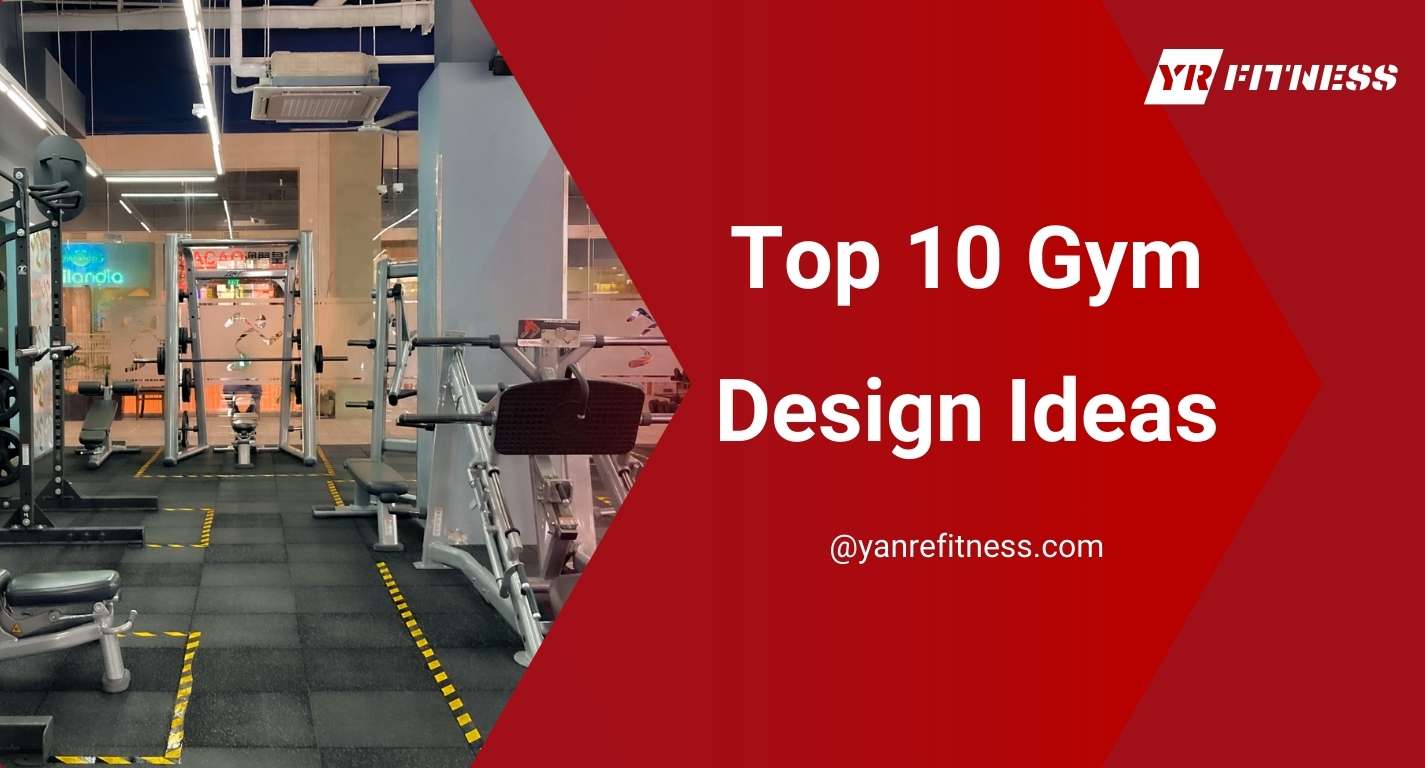Are you planning to upgrade your gym design but feeling overwhelmed by all the design choices? A well-designed gym can make or break the user experience and the success of your business.
As a gym designer, I’ve helped many business owners create spaces that are functional, visually appealing, and highly effective for members.
Here’s a preview of 2 of the best gym design that I find particularly appealing:
- Open Concept Layout
- Zoned Workout Areas
In this guide, you’ll explore the 10 gym design ideas to optimizing space for different workout styles. You’ll learn how to turn your design vision into reality.
Let’s dive in!
Table of Contents
- 1. Open Concept Layout
- 2. Zoned Workout Areas
- 3. Natural Lighting & Large Windows
- 4. Innovative Lighting Solutions
- 5. Unique Wall Murals & Motivational Quotes
- 6. High-Tech Integration
- 7. Sustainable Design & Eco-Friendly Materials
- 8. Comfortable Relaxation Zones
- 9. Vibrant Color Schemes
- 10. Interactive Mirrors & Digital Displays
- Conclusion
- Dive Deeper Into Our Resources
1. Open Concept Layout
An open concept layout in a gym is designed to create a sense of space, making the facility feel more inviting and less crowded. It allows gym members to move freely between different workout zones, enhancing their overall experience. Here are examples of how open concept layouts can be applied in gym design:
- Large Central Workout Space: A central area that is free of walls or partitions creates an open environment for high-traffic activities, like free weights or functional training. This layout allows gym members to move around freely while promoting interaction between different workout groups and classes.
- Clear Pathways for Flow: Design clear pathways to guide members from one workout area to another without obstacles. Did you know that wide walkways between cardio machines and strength training zones help members move easily, reducing crowding and improving traffic flow throughout the gym.
- Visible Trainer Areas: In an open layout, trainers can have a clear view of the entire gym. This visibility helps them monitor members, offer assistance, and create a more engaging environment. It also makes it easier for members to access trainers when they need guidance.
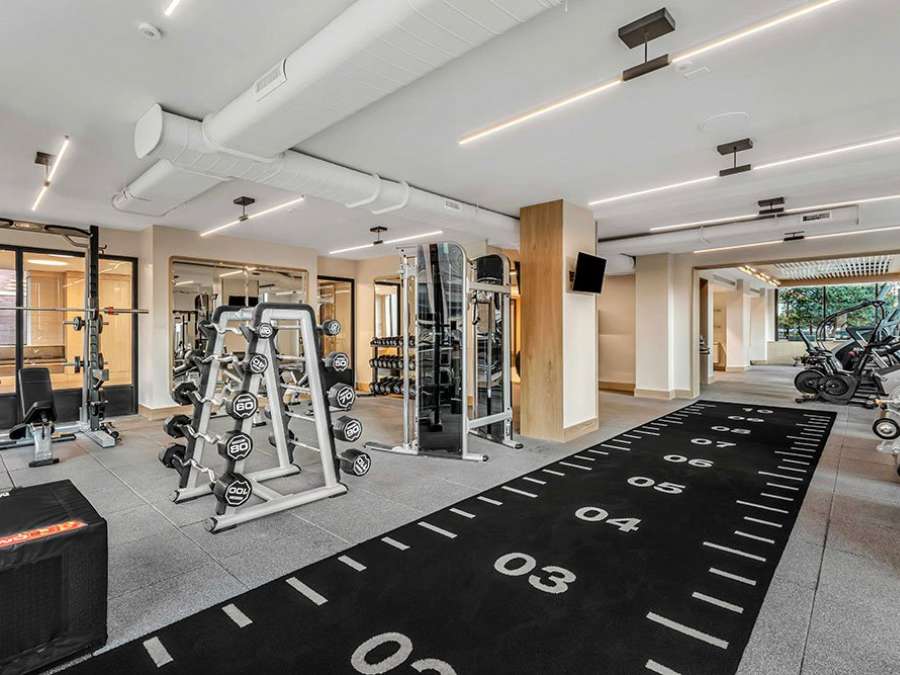
2. Zoned Workout Areas
Zoning workout areas in a gym helps create a more organized and efficient environment for members. By designating specific areas for different types of exercises, gym owners can improve flow and reduce crowding. Here are 4 examples of how zoning can be applied:
- Cardio Zone: A dedicated area for cardio machines, such as treadmills, stationary bikes, and ellipticals, keeps high-energy activities together. This allows members to focus on cardiovascular training in a space designed for movement and helps maintain a structured layout for other equipment.
- Strength Training Zone: This section houses free weights, benches, and strength machines. Grouping strength equipment in one area helps members access everything they need for weight training in a concentrated space. It also creates a safer environment by separating heavy lifting from other activities.
- Functional Training Zone: An open space for bodyweight exercises, kettlebell workouts, or resistance band training. Functional training zones provide members with room to move freely, especially for workouts that require flexibility, without being restricted by nearby equipment.I guess, aside from alloting a space for specific workouts, it’s also important for gym owners to invest in high-quality equipment like YR Fitness.
- Stretching and Recovery Zone: A calm, open area for stretching, foam rolling, and recovery activities. By placing this zone away from high-intensity workout areas, members can relax and cool down after their workout without distraction, improving overall recovery and wellness.

3. Natural Lighting & Large Windows
Natural lighting and large windows can transform a gym, making it feel more open, fresh, and energizing. Natural light provides essential vitamins, which many people miss due to spending 90% of their time indoors, according to Cantifix. Incorporating these elements improves both functionality and aesthetics, creating a more inviting space. Here are some examples of how gyms benefit from natural lighting and large windows:
- Floor-to-Ceiling Windows: Installing floor-to-ceiling windows allows maximum sunlight to flood the gym, brightening up the entire space. This type of window design creates an open and airy feeling, making even small gyms feel more spacious and less enclosed.
- Skylights for Additional Light: Skylights are a great option for gyms located in crowded urban areas where side windows may not be possible. They allow sunlight to enter from above, filling the space with natural light without sacrificing privacy or wall space.
- Glass Walls in High-Traffic Areas: Using glass walls in high-traffic areas like entrance lobbies or between workout zones allows natural light to flow freely throughout the gym. This design keeps the facility bright while maintaining separation between different workout areas.
- Window Placement in Cardio Zones: Positioning large windows near cardio machines like treadmills and bikes gives members a view while they exercise. It creates a more pleasant experience, allowing them to stay engaged with their surroundings rather than feeling trapped indoors. High quality equipment from trusted manufacturers like YR Fitness must give proper lighting to highlight its best features, right?
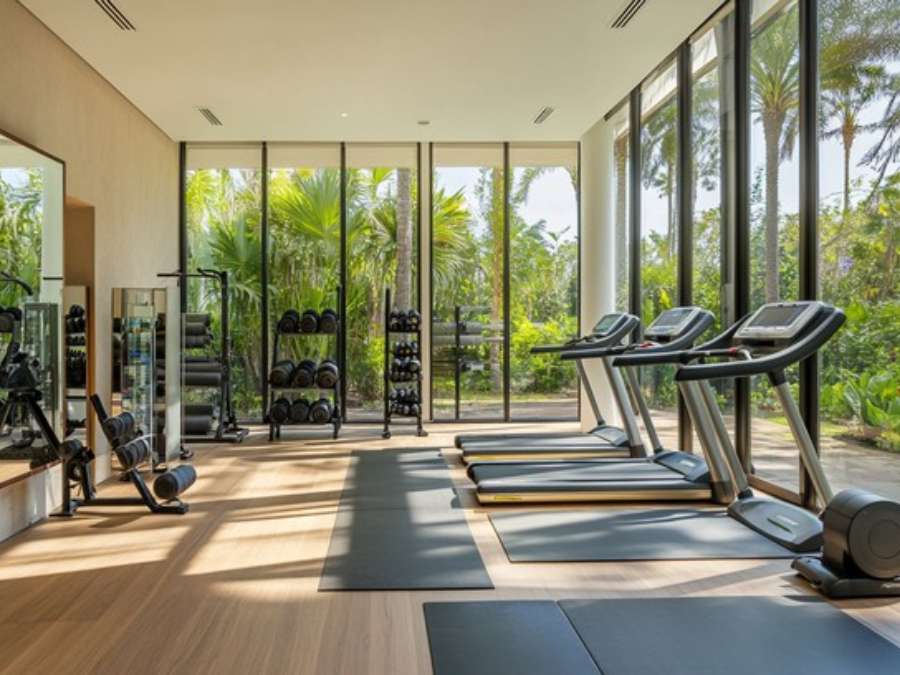
4. Innovative Lighting Solutions
ighting plays a crucial role in setting the mood and enhancing the overall workout experience in a gym. Innovative lighting solutions can transform the gym environment, making it more dynamic and functional for both members and staff. To guide you,here are some examples of how gyms can incorporate innovative lighting solutions:
- Adjustable LED Lighting: Using LED lights with adjustable brightness allows gym owners to create different lighting levels based on the time of day or activity. For example, brighter lighting during peak hours can energize members, while dimmer lighting in relaxation zones promotes a calming atmosphere.
- Motion-Activated Lighting: Motion sensors can be installed to activate lighting only when someone enters a specific area. This not only saves energy but also adds convenience, particularly in spaces like storage rooms or hallways that are used less frequently.
- Colored Accent Lighting: Adding colored lights to certain areas, such as around mirrors or in group fitness zones, can create a vibrant and motivating atmosphere. Colors can be chosen to match the gym’s branding or to enhance specific workout areas for a more exciting experience.
- Smart Lighting Systems: Smart lighting can be programmed to adjust automatically based on the gym’s schedule. Lights can change intensity throughout the day or switch to different modes for various activities, reducing the need for manual adjustments and creating a seamless gym experience.
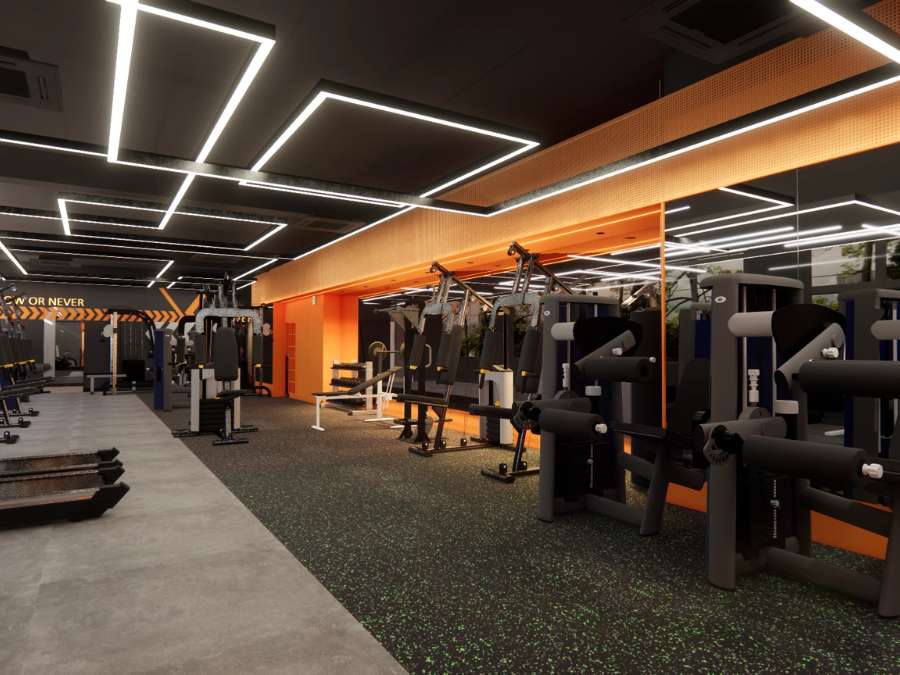
5. Unique Wall Murals & Motivational Quotes
Wall murals and motivational quotes can significantly impact the atmosphere of a gym. They create an inspiring environment that motivates members to push harder during their workouts. By using visually appealing designs and powerful words, gym owners can enhance the overall aesthetic and energy of their facility. Here are 4 examples of how to use wall murals and motivational quotes in gym design:
- Bold Motivational Phrases: Large, bold quotes like “No Excuses” or “Stronger Every Day” placed in workout zones can inspire members during tough workouts. These phrases keep motivation high and remind members to stay focused on their fitness goals.
- Fitness-Themed Murals: Wall murals featuring athletes in action or images of nature’s strength can create a visually stimulating atmosphere. These murals can be placed in high-traffic areas, like near the entrance or cardio zones, to set an energetic tone as soon as members walk in.
- Interactive Murals with Social Media Tags: Creating a mural that encourages gym members to take photos and share them on social media can boost community engagement. Including hashtags or the gym’s social media handle in the design encourages members to post and promote the gym online.
- Quotes in Relaxation Areas: Soft, calming quotes like “Breathe and Relax” can be placed in stretching or cool-down zones. As a matter of fact,these phrases help members transition from high-intensity workouts to recovery, promoting a balanced experience in the gym.
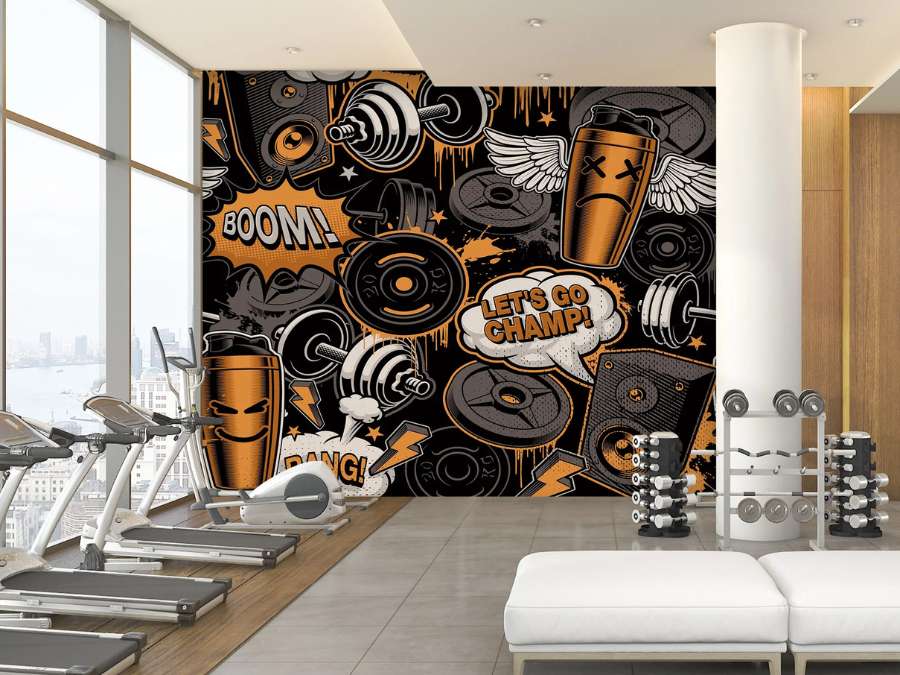
6. High-Tech Integration
Integrating high-tech solutions in gym design offers a modern and convenient workout experience for members. By incorporating advanced technology, gym owners can improve functionality, enhance engagement, and streamline operations. Here are some examples of how high-tech integration can be applied in gym settings:
- Smart Equipment: Smart fitness machines track user performance, offering real-time data such as calories burned, heart rate, and distance covered. This technology allows members to monitor their progress and adjust their workout routines, creating a more personalized and efficient experience. Sounds amazing, right?
- Fitness Apps and Wearables: Gyms can collaborate with fitness apps or provide wearable devices that sync with machines and workout programs. Members can track their progress over time, access customized workout plans, and receive real-time feedback, boosting engagement and results.
- Digital Check-In Systems: Installing digital check-in systems allows members to access the gym easily using a key card, phone app, or fingerprint scan. This not only speeds up the entry process but also improves security by keeping track of who is in the gym at any given time.
- Virtual Classes: Offering virtual fitness classes via large screens or personal devices allows members to participate in group workouts, even when instructors aren’t available. Virtual classes give gyms the flexibility to offer a variety of programs around the clock, catering to different schedules.
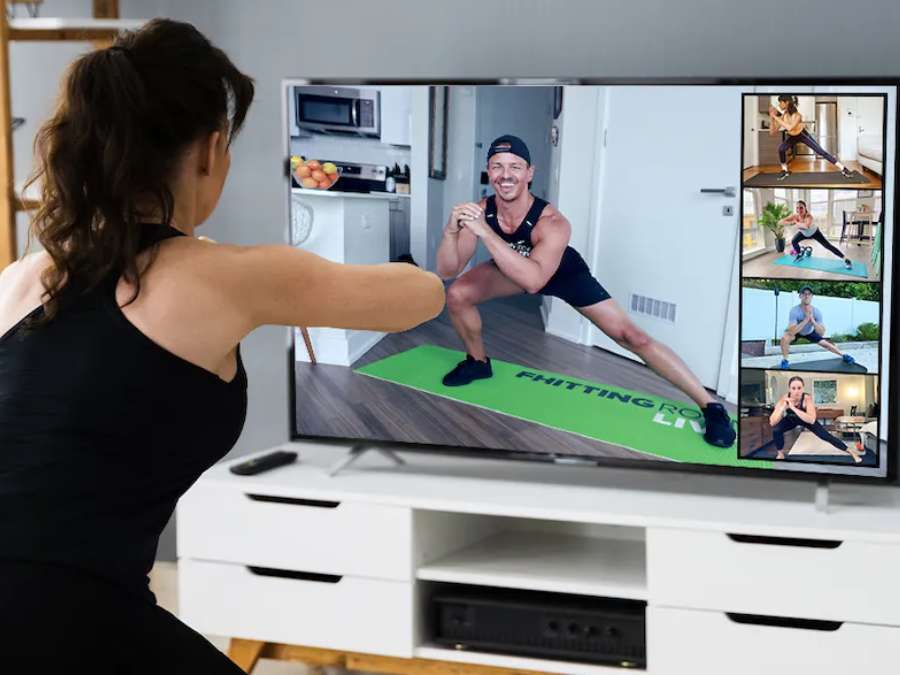
7. Sustainable Design & Eco-Friendly Materials
Incorporating sustainable design and eco-friendly materials into gym facilities not only helps the environment but also creates a healthier atmosphere for members. Gym owners can benefit from lower operational costs while contributing to a greener planet. Here are 4 examples of how sustainable design can be applied:
- Energy-Efficient Lighting: Installing LED lighting throughout the gym reduces energy consumption and costs. LED bulbs last longer and use less electricity compared to traditional lighting, making them an eco-friendly choice that benefits both the environment and the gym’s budget.
- Recycled Flooring Materials: Gyms can use flooring made from recycled materials, such as rubber or vinyl, for workout areas. And on top of that, these materials are durable and provide excellent shock absorption, while also supporting sustainability by reducing waste in landfills.
- Water Conservation Systems: Installing water-efficient fixtures like low-flow faucets and toilets helps gyms reduce water usage. These systems lower utility costs while promoting sustainability, especially in locker rooms and restrooms where water use is high.
- Solar Power Integration: Utilizing solar panels to power gym equipment or lighting can significantly reduce the gym’s carbon footprint. Solar energy is a renewable resource that not only supports sustainability but also offers long-term savings on electricity bills.

8. Comfortable Relaxation Zones
Creating comfortable relaxation zones in a gym helps members recharge between workouts or after a session. These areas offer a space where members can unwind, promoting recovery and overall wellness. Below are 4 examples of how gym owners can design comfortable and inviting relaxation zones:
- Cozy Seating Areas: Providing comfortable seating, like sofas or lounge chairs, creates a welcoming space where members can rest. This area can be placed near the entrance or in a quieter section of the gym, offering members a spot to relax after an intense workout.
- Hydration Stations: Installing hydration stations with water coolers or smoothie bars near relaxation zones encourages members to stay hydrated. Offering healthy drink options adds a wellness element to the gym, making it more than just a place to exercise.
- Spa-Inspired Features: Adding spa-like features such as dim lighting, soft music, and calming scents to relaxation zones can enhance the overall atmosphere. These touches create a peaceful retreat where members can unwind, promoting mental and physical well-being.
- Charging Stations and Wi-Fi Access: Providing charging stations and Wi-Fi access in relaxation areas allows members to recharge their devices while they relax. I must say that this adds convenience, especially for members who may want to catch up on emails or listen to music after their workout.
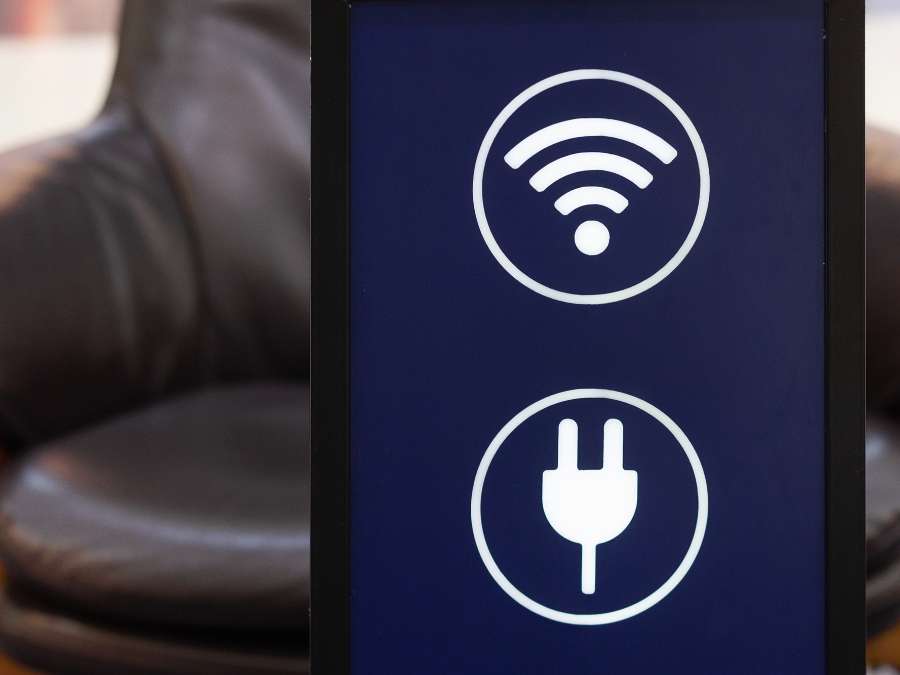
9. Vibrant Color Schemes
Using vibrant color schemes in gym design can create an energetic and motivating environment for members. Here’s the interesting part: the right color choices can influence mood, enhance the overall atmosphere, and make the gym feel more inviting. Here are some examples of how vibrant color schemes can be applied in a gym setting:
- Bold Reds and Oranges for Energy: Bright red and orange tones can be used in high-energy areas like weightlifting zones or cardio sections. These colors stimulate excitement and intensity, helping to keep members motivated during vigorous workouts.
- Calming Blues and Greens for Recovery Areas: Softer hues like blue and green work well in relaxation or stretching zones. These colors promote calmness and relaxation, offering a peaceful setting for members to unwind and recover after intense sessions.
- Yellow Accents for Positivity: Yellow is a color that evokes feelings of happiness and optimism. Adding yellow accents throughout the gym, such as in locker rooms or common areas, can create a welcoming and cheerful atmosphere that lifts the mood of gym-goers.
- Color-Coded Zones: Using different colors to define specific workout areas helps members navigate the gym with ease. For example, cardio equipment could be surrounded by cool tones, while strength training areas might feature bold, energizing colors, creating a visually organized space.
The table below shows breaks down the various color schemes, their applications, and the effects they create in a gym setting:
Color Scheme | Specific Colors | Application | Effects |
Bold Reds and Oranges | Fire Red (#FF4500),Scarlet Red (#FF2400),Tangerine (#FF6347),Orange Peel (#FFA500) | Weightlifting zones, cardio sections | Stimulates energy, excitement, and intensity |
Calming Blues and Greens | Sky Blue (#87CEEB)Aqua (#00FFFF)Mint Green (#98FF98)Sea Green (#2E8B57) | Relaxation or stretching areas | Promotes calmness, relaxation, and recovery |
Yellow Accents | Lemon Yellow (#FFF44F),Goldenrod (#DAA520),Canary Yellow (#FFEF00) | Locker rooms, common areas | Evokes positivity, happiness, and optimism |
Color-Coded Zones | Powder Blue (#B0E0E6)Light Gray (#D3D3D3)Crimson (#DC143C)Flame Orange (#FF4500) | Cardio and strength training areas | Helps with gym navigation and organization |
10. Interactive Mirrors & Digital Displays
Interactive mirrors and digital displays are modern tools that can greatly enhance the gym experience for members. They provide real-time feedback, improve engagement, and make workouts more dynamic and personalized. Here are 5 examples of how gyms can integrate interactive mirrors and digital displays effectively:
- Real-Time Workout Feedback: Interactive mirrors can track members’ movements during exercises, providing real-time feedback on their form and technique. This helps gym-goers correct mistakes instantly, leading to safer and more effective workouts without the constant need for personal trainer supervision.
- Virtual Fitness Classes: Digital displays in group fitness areas can broadcast virtual fitness classes. This allows members to participate in various types of workouts, such as yoga or HIIT, on demand, without needing an in-person instructor. It adds convenience and variety to the gym experience.
- Progress Tracking Displays: Digital displays connected to workout machines can track performance metrics like calories burned, distance covered, or weight lifted. Members can see their progress in real time, which keeps them motivated and engaged throughout their workout session.
- Interactive Personal Training: Interactive mirrors can also offer personal training sessions by displaying exercises and guiding members through customized routines. And the best part is these mirrors can be programmed to adjust workouts based on individual fitness goals, creating a tailored experience without the need for in-person trainers.
- Gamification of Workouts: Digital displays can gamify workouts by allowing members to compete with themselves or others. A display might track how fast someone completes a circuit or how much weight they’ve lifted, turning fitness into a fun and competitive experience.
Conclusion
What is your favorite gym design idea? We hope you’ve discovered some concepts that inspire you to create an engaging and motivating environment for your gym instructors and clients. Designing the perfect gym can significantly enhance the workout experience and keep everyone focused on their fitness goals.
If you’re ready to take your gym to the next level, YR Fitness provides a wide selection of top-quality equipment tailored to your needs. Contact us today and let’s work together to elevate your gym!
Dive Deeper Into Our Resources
For some insightful reads, we’ve curated a list of recommended articles just for you:
- Opening A Gym
- Gym Equipment Floor Plan
- Hotel Gym Design
- CrossFit Gym
- Luxury Gyms
- Gym Layout Design
- Small Gym Interior Design
Still haven’t found what you’re looking for? Don’t hesitate to contact us. We’re available around the clock to assist you.
Related articles:
